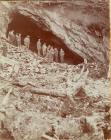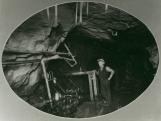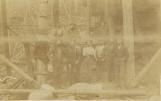1
Stopeing Ore possibly at Silver King Mine
1890
Silver King Mine, Toad Mountain, near Nelson B.C

2
During the spring of 1899 a strike of a somewhat different nature affected the mines of the West Kootenay - a labour strike. Provincial legislature had introduced an amendment to the Metaliferous Mine Act stating: 'No person shall be employed in any metaliferous mine for more than eight hours in every twenty-four hours.'
3
Visitors standing at the entrance to a tunnel at the Silver King Mine.
1896
Toad Mountain, near Nelson B.C

4
The mine owners were outraged. Anger was directed specifically at the Minister of Mines, John F. Hume, who was also the provincial representative for Nelson. They asserted that he had concealed his interest in labour legislation whilst canvassing as a candidate. They argued that a reduction from twenty to sixteen hours of labour would necessitate three shifts a day and result in a 20 percent reduction in productivity. Moreover, many of the mines were not paying dividends and could ill-afford such a burden.
5
Large Group at the Bunkhouse, Silver King Mine.
1899
Toad Mountain, near Nelson B.C

6
Represented by their organization, the Silver-Lead Mines Association of British Columbia, a delegation was sent to lobby Hume in Victoria for the repeal of the law. The government agreed not to enforce the legislation, and the delegation returned to Nelson. Much bitterness ensured when they were met by the Provincial Inspector of Mines, prepared to enforce the Act.
7
Checking the Steam Compressor at the Silver King Mine.
1896
Toad Mountain, near Nelson B.C

8
The Association announced that commencing June 1st, a reduction in hours worked would be matched with a reduction in wages from $3.50 to $3.00 a day for skilled miners and other workers accordingly.
9
Nelson Miner's Union members badge
1895

10
On May 17, 1899 the Nelson Miners' Union was formed and 260 men joined. A union already existed at Rossland and others sprang up in Ymir, Sandon and Silverton. On June 1st, many of the miners struck. Although the majority of the mines in the Nelson district continued to operate, most closed in the Slocan. Strikebreakers were imported and a party of special constables was brought into Ymir. A bitter fight developed.
11
Nelson Miner's Union members badge
1896

12
A provincial enquiry, launched by the government in an attempt to break the deadlock between the mine owners and the strikers proved to be fruitless. The strike continued until March 1900 when the mine owners conceded to pay $3.25 a day to the miners.
13
Halfway Station Crew of the Silver King Mine Tramway.
1896
Toad Mountain, near Nelson B.C

14
Although the Silver King mine had remained open, despite a reduction in the workforce from 200 to 130 men, the loss of the ores from the Slocan significantly reduced the output at the smelter. It closed temporarily in March and reopened in August under the control of the new company.






